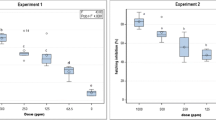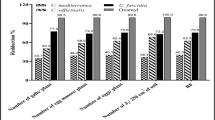Abstract
Terpenes are secondary metabolites produced in different biological pathways as defense mechanisms against, among others, nematodes, insects and herbivores. Root-knot nematodes (RKN; Meloidogyne spp.) are one of the most serious pests of economically importance for vegetable production in Greece. The aim of this study was to investigate the nematicidal activity of geraniol on different life stages at 35–1000 ppm doses against the root-knot nematode Meloidogyne javanica. To our knowledge, this study is the first to report the effect of geraniol on egg differentiation and also its sub-lethal doses effect. Experiments testing the contact action of geraniol resulted in about 100% mortality of J2 s, whereas vapor showed only about 10%. Particularly, geraniol paralyzed 100% of second-stage juveniles (J2 s) and inhibited egg hatching in about 70%, at a dose of 500 ppm. In pot experiment, the use of geraniol at sub-lethal doses reduced female numbers in tomato roots. To the contrary, no nematostatic effects were observed in paralysis bioassays. The present study strongly demonstrates geraniol’s toxic effect against root-knot nematode Meloidogyne javanica.





Similar content being viewed by others
References
Al-Banna, L., Darwish, R. M., & Aburjai, T. (2003). Effect of plant extracts and essential oils on root-knot nematode. Phytopatologia Meditarranea, 42(2), 123–128.
Ali, A., Murphy, C. C., Demirci, B., Wedge, D. E., Sampson, B. J., Khan, I. A., Baser, K. H. C., & Tabanca, N. (2013). Insecticidal and biting deterrent activity of rose-scented geranium (Pelargonium spp.) essential oils and individual compounds against Stephanitis pyrioides and Aedes aegypti. Pest Management Science, 69(12), 1385–1392.
Aytac, Z., Yildiz, Z. I., Kayaci-Senirmak, F., Keskin, N. O. S., Tekinay, T., & Uyar, T. (2016). Electrospinning of polymer-free cyclodextrin/geraniol-inclusion complex nanofibers: Enhanced shelf-life of geraniol with antibacterial and antioxidant properties. RSC Advances, 6(52), 46089–46099.
Back, M. A., Haydock, P. P. J., & Jenkinson, P. (2002). Disease complexes involving plant parasitic nematodes and soilborne pathogens. Plant Pathology, 51(6), 683–697.
Bleve-Zacheo, T., Mellilo, M. T., & Castagnone-Sereno, P. (2007). The contribution of biotechnology to root-knot nematode control in tomato plants. Pest Technology, 1(1), 1–16.
Brown, D. J. F., & Boag, B. (1988). An examination of methods used to extract virus-vector nematodes (Nematoda: Longidoridae and Trichodoridae) from soil samples. Nematologia Mediterranea, 16(1), 93–99.
Byrd, D.W., Krickpatrick, T, Barker, K.R. (1983). An improved technique for cleaning and staining plant tissue for detection of nematodes. Journal of Nematology, 15(1), 142–143.
Chitwood, D. J. (2003). Research on plant-parasitic nematode biology conducted by the United States Department of Agriculture-Agricultural Research Service. Pest Management Science, 59(6–7), 748–753.
D'Addabbo, T., Laquale, S., Lovelli, S., Candido, V., & Avato, P. (2014). Biocide plants as a sustainable tool for the control of pests and pathogens in vegetable cropping systems. Italian Journal of Agronomy, 9(4), 137–145.
Echeverrigaray, S., Zacaria, J., & Beltrão, R. (2010). Nematicidal activity of monoterpenoids against the root-knot nematode meloidogyne incognita. Phytopathology, 100(2), 199–203.
Faria, J. M. S., Sena, I., Ribeiro, B., Rodrigues, A. M., Maleita, C. M. N., Abrantes, I., Bennett, R. N., Mota, M., & Figueiredo, A. C. (2016). First report on Meloidogyne chitwoodi hatching inhibition activity of essential oils and essential oils fractions. Journal of Pest Science, 89(1), 207–217.
Flegg, J. J. M. (1967). Extraction of Xiphinema and Longidorus species from soil by a modification of Cobb’s decanting and sieving technique. Annals of Applied Biology, 60(3), 429–437.
Giannakou, I. O. (2011). Efficacy of a formulated product containing Quillaja Saponaria plant extracts for the control of root-knot nematodes. European Journal of Plant Pathology, 130(4), 587–596.
Huang, G., Allen, R., Davis, E. L., Baum, T. J., & Hussey, R. S. (2006). Engineering broad root-knot resistance in transgenic plants by RNAi silencing of a conserved and essential rootknot nematode parasitism gene. Proceedings of the National Academy of Sciences of the United States of America, 103(39), 14302–14306.
Hussey, R. S., & Barker, K. R. (1973). A comparison of methods of collecting inocula of Meloidogyne spp., including a new technique. Plant DiseaJse Reports, 57, 1025–1028.
Ibrahim, S. K., Traboulsi, A. F., & El-Haj, S. (2006). Effect of essential oils and plant extracts on hatching, migration and mortality of Meloidogyne incognita. Phytopathologia Mediterranea, 45(3), 238–246.
Kabera, J. N., Semana, E., Mussa, A. R., & He, X. (2014). Plant secondary metabolites: Biosynthesis, classification, Function and Pharmacological Properties. Journal of Pharmacy and Pharmacology, 2, 377–392.
Karpouzas, D. G., Hatziapostolou, P., Papadopoulou-Mourkidou, E., Giannakou, I. O., & Georgiadou, A. (2004). The enhanced biodegradation of fenamiphos in soils from previously treated sites and the effect of soil fumigants. Environmental Toxicology and Chemistry, 23(9), 2099–2107.
La Rocca, V., da Fonsêca, D. V., Silva-Alves, K. S., Ferreira-da-Silva, F. W., de Sousa, D. P., Santos, P. L., Quintans-Júnior, L. J., Leal-Cardoso, J. H., & de Almeida, R. N. (2017). Geraniol Induces Antinociceptive Effect in Mice Evaluated in Behavioural and Electrophysiological Models. Basic & Clinical Pharmacology & Toxicology, 120(1), 22–29.
Lee, B.-H., Lee, S.-E., Annis, P. C., Pratt, S. J., Park, B.-S., & Tumaalii, F. (2002). Fumigant Toxicity of Essential Oils and Monoterpenes Against the Red Flour Beetle, Tribolium castaneum Herbst. Journal of Asia-Pacific Entomology, 5(2), 237–240.
López-Meneses, A. K., Sánchez-Mariñez, R. I., Quintana-Obregón, E. A., Parra-Vergara, N. V., González-Aguilar, G. A., López-Saiz, C. M., & Cortez-Rocha, M. O. (2017). In vitro Antifungal Activity of Essential oils and Major Components against Fungi Plant Pathogens. Journal of Phytopathology, 165(4), 232–237.
Martin, F. N. (2003). Development of alternative strategies for management of soilborne pathogens currently controlled with methyl bromide. Annual Review of Phytopathology, 41, 325–350.
Melo, C. H. D., de Freitas, M. A., Figueiredo, L. G. C. N., Sabino, A. R., de Alencar, F. J. V. & Cosmo, A. J. (2015). In vitro antimicrobial activity of geraniol and cariophyllene against Staphylococcus aureus. Revista Cubana de Plantas Medicinales, 20(1), 98–105.
Moens, M., Perry, N. P., & Starr, L. J. (2009). Root-knot nematodes. Wallingford: CAB International.
Nasiou, E., & Giannakou, I. O. (2017). The potential use of carvacrol for the control of Meloidogyne javanica. European Journal of Plant Pathology, 149(2), 415–424.
Ntalli, N. G., & Caboni, P. (2012). Botanical nematicides in the mediterranean basin. Phytochemistry Reviews, 11(4), 351–359.
Ntalli, N.G. & Menkissoglu-Spiroudi, U. (2011). Pesticides of botanical origin: A promising tool in plant protection. In M. Stoytcheva (Ed.), Pesticides-formulations, effects, fate. Ch. 1, (pp. 3-24). InTech..
Ntalli, N. G., Ferrari, F., Giannakou, I., & Menkissoglu-Spiroudi, U. (2010). Phytochemistry and nematicidal activity of the essential oils from 8 greek lamiaceae aromatic plants and 13 terpene components. Journal of Agricultural and Food Chemistry, 58(13), 7856–7863.
Ntalli, N. G., Ferrari, F., Giannakou, I., & Menkissoglu-Spiroudi, U. (2011). Synergistic and antagonistic interactions of terpenes against Meloidogyne incognita and the nematicidal activity of essential oils from seven plants indigenous to Greece. Pest Management Science, 67(3), 341–351.
Oka, Y., Nacar, S., Putievsky, E., Ravid, U., Yaniv, Z., & Spiegel, Y. (2000). Nematicidal activity of essential oils and their components against the root-knot nematode. Phytopathology, 90(7), 710–715.
Orion, D., Kritzman, G., Meyer, S. L., Erbe, E. F., & Chitwood, D. J. (2001). A role of the gelatinous matrix in the resistance of root-knot nematode (Meloidogyne spp.) eggs to microorganisms. Journal of Nematology, 33(4), 203–207.
Papadopoulou, E. S., Lagos, S., Spentza, F., Vidiadakis, E., Karas, P. A., Klitsinaris, T., & Karpouzas, D. G. (2016). The dissipation of fipronil, chlorpyrifos, fosthiazate and ethoprophos in soils from potato monoculture areas: First evidence for the enhanced biodegradation of fosthiazate. Pest Management Science, 72(5), 1040–1050.
Tzortzakakis, E. A., & Trudgill, D. L. (2005). A comparative study of the thermal time requirements for embryogenesis in Meloidogyne javanica and M. incognita. Nematology, 7(2), 313–315.
Walker, J. T., & Melin, J. B. (1996). Mentha piperita, Mentha spicata and effects of their essential oils on Meloidogyne in soils. Journal of Nematology, 28(4S), 629–635.
Yu, D., Wang, J., Shao, X., Xu, F., & Wang, H. (2015). Antifungal modes of action of tea tree oil and its two characteristic components against Botrytis cinerea. Journal of Applied Microbiology, 119(5), 1253–1262.
Acknowledgements
Authors are thankful to Tzortzakakis Emmanuel for the nematode specie speciment.
Author information
Authors and Affiliations
Contributions
Nasiou Eleni is a PhD student, designed and conducted the exrperiments, analyzed data and wrote the manuscript. Ioannis Giannakou is Ms. Nasiou’s supervisor, supervised the experiments and corrected the first draft of the manuscript.
Corresponding author
Ethics declarations
Conflict of interest
The authors declare that they have no conflict of interest.
Ethical statement
There are no ethical issues related to this manuscript.
Rights and permissions
About this article
Cite this article
Nasiou, E., Giannakou, I.O. Effect of geraniol, a plant-based alcohol monoterpene oil, against Meloidogyne javanica. Eur J Plant Pathol 152, 701–710 (2018). https://doi.org/10.1007/s10658-018-1512-x
Accepted:
Published:
Issue Date:
DOI: https://doi.org/10.1007/s10658-018-1512-x




